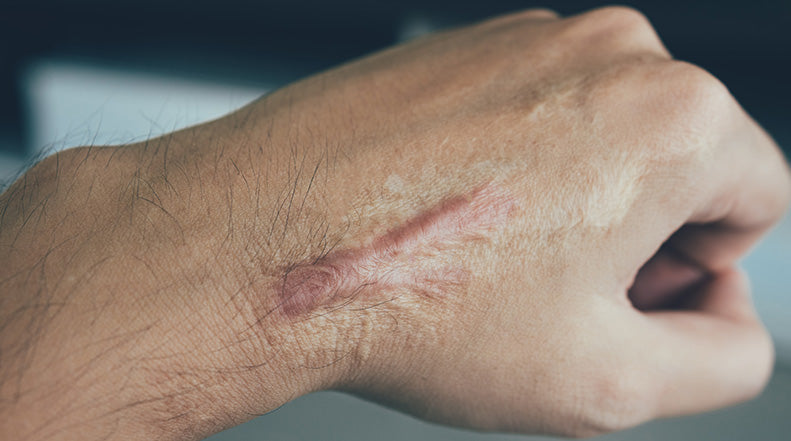5 Tips to Help Ensure a Good-Looking Thyroidectomy Scar

Hi! I’m Lisa, the Marketing Director for the company that makes NewGel+. Scar concerns are very close to my heart because I had thyroid surgery and was petrified of having a bad scar. Since January is Thyroid Awareness Month, I thought this may be a great time to share my own thyroid story.
My doctor detected an enlargement of the left side of my thyroid gland right around my 29th birthday, when my son was only 7 months old. At the time my thyroid seemed to be functioning normally, but as my doctor described, it was enlarging to keep up with thyroid hormone production. (think building a bigger factory)
I was referred to an endocrinologist and began regular testing to monitor my thyroid – bloodwork to check hormone levels, ultrasounds to monitor size, and fine needle aspirations to check for cancer. One of the first tests ordered was a RAIU, or radioactive iodine uptake scan. Some of these were scary for me. The aspiration needles are really long, and there is no numbing or sedation. When I went for the RAIU someone in essentially a hazmat suit held out a lead container, tipped a pill out, and told me to swallow it. What?!? Let me put your mind at ease and dispel some concerns and misinformation.
Fine needle aspiration doesn’t hurt. The needle is very thin, and the only pain is a slight pinch when it goes into your skin. The thyroid gland does not have any sensory nerves, so you do not feel it. You may have the sense of something moving internally, but it does not hurt. The benefits of cancer testing definitely outweigh any discomfort. Do it!
RAIU scan does not make you “radioactive.” The nurse at the hospital where I had my test told me I couldn’t hold my baby or be closer than 6 feet. She was misinformed. The amount of radiation used for the scan is minor and there is no need for radiation precautions. The radiation levels for amounts given to treat hyperactive thyroid or thyroid cancer are significantly higher and do require some precautions.
I was diagnosed with a multi-nodular goiter, which my doctor said resembled a cluster of grapes on my thyroid. I noticed it was getting larger over time, and my endocrinologist recommended that I go for a surgical consult for a thyroidectomy. I went for the consult and was disappointed to learn that the only way to remove the thyroid is via an incision on the neck. This was not acceptable to me. I was young! I was a mom! My neck is so visible! I worried that my kids would be afraid of “Frankenmommy” or embarrassed by me. I even worried that people would assume I tried to harm myself. My imagination and fears worked overtime, and I did not schedule the surgery. I guess a large lump in my neck, not to mention the possible risk of cancer, was preferable to the idea of a scar across my neck.
I let my goiter get so big that it was compressing my esophagus and trachea. At that point, my endocrinologist said it needs to come out. Long story short, I had surgery (no cancer!), I wore a lot of turtlenecks and scarves tied around my neck, and it healed nicely. No one even notices my scar unless I point it out to them. How do I get all those years of worry back?
Here are some pointers that I would give anyone told they need a thyroidectomy:
5 Tips to Help Ensure a Good-Looking Thyroidectomy Scar:
- Pay attention to your nutrition and stop smoking: Healthy, oxygenated skin heals best.
- Choose your surgeon wisely: I was offered referrals to a General Surgeon or an ENT (Ear Nose & Throat) Surgeon. I chose the ENT Surgeon, as many of them also do facial plastic surgery. I had my surgery at a teaching hospital, and I made my surgeon promise me that he would do the closure, not a trainee. I made it VERY clear that I was extremely concerned with the scar appearance and wanted it minimized every way possible.
- Discuss incision placement: I had a hemithyroidectomy (only half removed), so my surgeon said he would place my incision off to the side and in a natural crease on my neck. I see so many thyroidectomy scars that are dead center and quite low on the neck. They almost seem on display. Ask if the neck crease option is possible, and if it can be to the side. He also sutured my incision using a running sub-cuticular stitch, so I have no “railroad tracks” or dots on either side.
- Protect your scar from the sun: I was a sales rep calling on dermatologists at the time of my surgery, and every doctor I asked about scar prevention gave me a different answer. The one thing EVERY ONE of them said, however, was to protect it from the sun, preferably for at least a year. I bought a sunscreen stick, the ones that look like a fat lip balm, and used it constantly over my scar. My scar to this day has no hyperpigmentation, so I highly recommend doing the same.
- Use a silicone scar product like NewGel+ or NewGel+E: As I said, at the time of my surgery (2002) no one really seemed to know what to do for scars. Now that I have the benefit of 15 years working with scar products and scar experts! Given my history it is quite serendipitous that this line of work found me! I definitely understand our customer. Knowing what I know now, I would most certainly choose NewGel+ for post-op scar treatment. I’d wear one of the strips (1”x6” or 2”x8”) while at home, and the NewGel+E when out in public. It is clinically proven and international experts on scars say silicone is the “gold standard” for scar treatment.
If you have any questions about thyroidectomy, I’d be happy to talk further. Just use our contact email and note that your message is for Lisa. Good luck and happy healing!




Comments